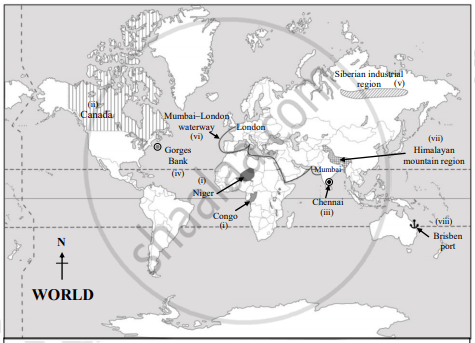Advertisements
Advertisements
प्रश्न
Show the following in the world map. Index is necessary
- Any two countries in the second stage of population transition
- A country having sparse population in North America
- Chennai- metro city
- Gorges Bank
- Siberian industrial region
- Mumbai – London waterway
- Himalayan mountain region
- Brisben port
उत्तर

Index:
 - Two countries in the second stage of population transition - Niger, Congo
- Two countries in the second stage of population transition - Niger, Congo - A country having sparse population in North America - Canada
- A country having sparse population in North America - Canada - Chennai- metro city
- Chennai- metro city - Gorges Bank
- Gorges Bank - Siberian industrial region
- Siberian industrial region - Mumbai – London waterway
- Mumbai – London waterway - Himalayan mountain region
- Himalayan mountain region - Brisben port
- Brisben port
APPEARS IN
संबंधित प्रश्न
Answer in detail:
In the first and fifth stages of the demographic transition, population growth is almost nil. What is the difference between the two stages then?
Identify the incorrect factor
The countries in the second stage of population transition:
Identify the incorrect factor
Characteristics of first stage of population transition theory:
Identify the correct group
Population transition theory – first stage:
Identify the correct group
Population transition theory- third stage:
Differentiate between
1st and 5th stage of population transition theory
Differentiate between
First stage and Second stage of population transition theory
Show the following in the world map. Index is necessary
- Any one country in the third stage of population transition
- A country having dense population in North America
- Madagaskar
- Lumbering in Africa
- New England – Industrial region
- Kochi to Tokyo – ocean route
- Mining region of Australia
- Callao port
Complete the chain:
| A |
B |
C |
|
(1) High Stationary |
(i) BR and DR both decrease |
(a) Population growth stable |
|
(2) Early Expanding |
(ii) BR very low than DR |
(b) Population growth rapid |
|
(3) Late Expanding |
(iii) BR and DR both very low |
(c) Population growth minimal |
|
(4) Low stationary |
(iv) BR and DR both are high |
(d) Population growth negative |
|
(5) Declining |
(v) BR constant and DR decreases |
(e) Population growth reduces |
|
|
(vi) DR High and BR low |
(f) No change in population growth |
Distinguish between:
Demographic transition theory Stage first and Stage five
